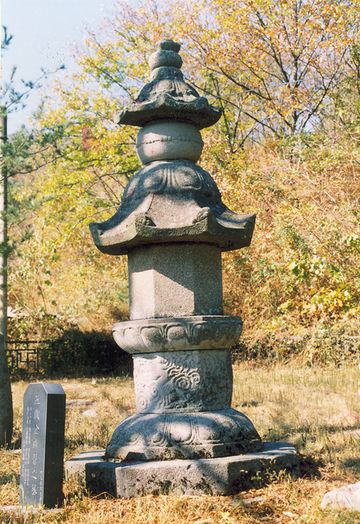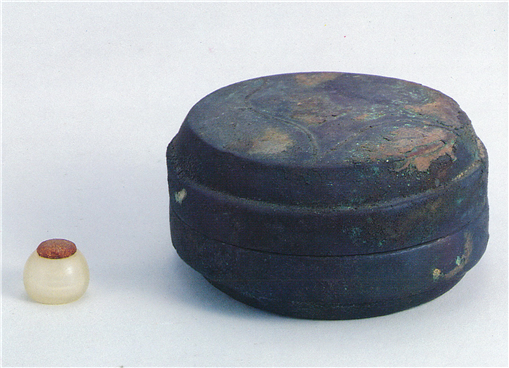"무량사 김시습 부도"의 두 판 사이의 차이
(→영문) |
|||
| (사용자 2명의 중간 판 3개는 보이지 않습니다) | |||
| 4번째 줄: | 4번째 줄: | ||
|사진출처="[http://www.heritage.go.kr/heri/cul/culSelectDetail.do?ccbaCpno=2113400250000 무량사 김시습 부도]", 국가문화유산포털, 문화재청. | |사진출처="[http://www.heritage.go.kr/heri/cul/culSelectDetail.do?ccbaCpno=2113400250000 무량사 김시습 부도]", 국가문화유산포털, 문화재청. | ||
|대표명칭=무량사 김시습 부도 | |대표명칭=무량사 김시습 부도 | ||
| − | |영문명칭= | + | |영문명칭=Stupa of Kim Si-seup in Muryangsa Temple |
|한자=無量寺 金時習 浮屠 | |한자=無量寺 金時習 浮屠 | ||
|주소=충청남도 부여군 외산면 만수리 산125-1번지 | |주소=충청남도 부여군 외산면 만수리 산125-1번지 | ||
| 32번째 줄: | 32번째 줄: | ||
===영문=== | ===영문=== | ||
| − | '''Stupa of Kim Si-seup in Muryangsa | + | '''Stupa of Kim Si-seup in Muryangsa Temple''' |
| − | A stupa is a structure containing the relics or remains of eminent Buddhist | + | A stupa is a structure containing the relics or remains of an eminent Buddhist monk. |
| − | This stupa was made in 1495 and contains the relics of Kim Si-seup (1435-1493), | + | This stupa was made in 1495 and contains the relics of Kim Si-seup (1435-1493), an eminent scholar of the early Joseon period. |
| − | Kim was known as a | + | Kim demonstrated excellent talent in learning and was known as a genius from a young age. However, in 1455, when King Sejo (r. 1455-1468) usurped the throne from his nephew King Danjong (r. 1452-1455), Kim became distraught and gave up his studies to become a Buddhist monk. As a monk, Kim roamed around the country and spent his final years at Muryangsa Temple in Buyeo. |
| − | When in the first half of the 20th century the stupa | + | When in the first half of the 20th century, the stupa toppled over due to a heavy rain, a container bearing the relics of Kim Si-seup was discovered. His relics are currently enshrined at the temple, and the container is displayed at the Buyeo National Museum. |
| − | The stupa’s design is | + | The stupa’s design is exquisitely detailed. |
| − | + | ===영문 해설 내용=== | |
| − | + | 부도는 스님의 사리나 유골을 모셔 놓은 일종의 무덤이다. | |
| − | + | 이 부도는 조선 전기의 대학자인 김시습(1435∼1493)의 사리를 모신 부도로 1495년에 만들어졌다. | |
| − | 조선 전기의 | ||
김시습은 어릴 때부터 학문에 뛰어나 천재로 불렸다. 그가 20세이던 1455년, 단종(재위 1452-1455)이 숙부인 세조(1455-1468)에게 왕위를 빼앗기자, 이에 좌절하여 학문을 접고 승려가 되었다. 이후 전국을 떠돌다가 남은 생을 부여의 무량사에서 보냈다. | 김시습은 어릴 때부터 학문에 뛰어나 천재로 불렸다. 그가 20세이던 1455년, 단종(재위 1452-1455)이 숙부인 세조(1455-1468)에게 왕위를 빼앗기자, 이에 좌절하여 학문을 접고 승려가 되었다. 이후 전국을 떠돌다가 남은 생을 부여의 무량사에서 보냈다. | ||
| − | 20세기 전반에 | + | 20세기 전반에 큰비로 부도가 넘어진 적이 있는데, 이때 부도 안에서 김시습의 사리를 넣은 사리기가 발견되었다. 사리는 무량사에 모셔지고, 사리기는 국립부여박물관에 소장되어 있다. |
| − | |||
| − | |||
| − | + | 이 부도는 조각이 화려하다. | |
=='''참고'''== | =='''참고'''== | ||
| 67번째 줄: | 64번째 줄: | ||
[[분류:시도유형문화재]] | [[분류:시도유형문화재]] | ||
[[분류:승탑]] | [[분류:승탑]] | ||
| + | [[분류:2019 영문집필]] | ||
2020년 6월 10일 (수) 09:51 기준 최신판
| 무량사 김시습 부도 Stupa of Kim Si-seup in Muryangsa Temple |
|
 "무량사 김시습 부도", 국가문화유산포털, 문화재청. |
|
| 대표명칭 | 무량사 김시습 부도 |
|---|---|
| 영문명칭 | Stupa of Kim Si-seup in Muryangsa Temple |
| 한자 | 無量寺 金時習 浮屠 |
| 주소 | 충청남도 부여군 외산면 만수리 산125-1번지 |
| 지정번호 | 시도유형문화재 제25호 |
| 지정일 | 1973년 12월 24일 |
| 분류 | 유적건조물/종교신앙/불교/탑 |
| 수량/면적 | 1기/413 |
| 웹사이트 | "무량사 김시습 부도", 국가문화유산포털, 문화재청. |
|
|
|
해설문
국문
부도는 불교에서 덕이 높은 스님을 화장(火葬)한 후에 나온 사리를 모시기 위해 세운 탑으로, 승려의 묘탑(墓塔), 혹은 승탑(僧塔)이라고 한다.
무량사의 김시습 부도는 조선 전기 문인이었던 매월당 김시습(1435∼1493)의 사리를 모신 것이다. 김시습은 생육신의 한 사람으로, 수양대군이 단종을 폐위하고 왕위에 오르자 21세에 승려가 되어 전국을 떠돌다가 남은 생을 무량사(無量寺)에서 보냈다.
일제강점기에 부도 안에서 김시습의 사리를 넣은 사리기가 발견되었다. 사리는 다시 무량사에 모셔졌고, 사리기는 국립부여박물관에 소장되어 있다.
이 부도는 조선 전기에 세워진 것 중에서 조각이 화려하고 뛰어나다고 평가된다.
영문
Stupa of Kim Si-seup in Muryangsa Temple
A stupa is a structure containing the relics or remains of an eminent Buddhist monk.
This stupa was made in 1495 and contains the relics of Kim Si-seup (1435-1493), an eminent scholar of the early Joseon period.
Kim demonstrated excellent talent in learning and was known as a genius from a young age. However, in 1455, when King Sejo (r. 1455-1468) usurped the throne from his nephew King Danjong (r. 1452-1455), Kim became distraught and gave up his studies to become a Buddhist monk. As a monk, Kim roamed around the country and spent his final years at Muryangsa Temple in Buyeo.
When in the first half of the 20th century, the stupa toppled over due to a heavy rain, a container bearing the relics of Kim Si-seup was discovered. His relics are currently enshrined at the temple, and the container is displayed at the Buyeo National Museum.
The stupa’s design is exquisitely detailed.
영문 해설 내용
부도는 스님의 사리나 유골을 모셔 놓은 일종의 무덤이다.
이 부도는 조선 전기의 대학자인 김시습(1435∼1493)의 사리를 모신 부도로 1495년에 만들어졌다.
김시습은 어릴 때부터 학문에 뛰어나 천재로 불렸다. 그가 20세이던 1455년, 단종(재위 1452-1455)이 숙부인 세조(1455-1468)에게 왕위를 빼앗기자, 이에 좌절하여 학문을 접고 승려가 되었다. 이후 전국을 떠돌다가 남은 생을 부여의 무량사에서 보냈다.
20세기 전반에 큰비로 부도가 넘어진 적이 있는데, 이때 부도 안에서 김시습의 사리를 넣은 사리기가 발견되었다. 사리는 무량사에 모셔지고, 사리기는 국립부여박물관에 소장되어 있다.
이 부도는 조각이 화려하다.
